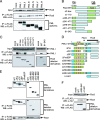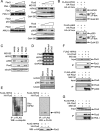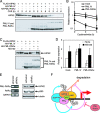PML activates transcription by protecting HIPK2 and p300 from SCFFbx3-mediated degradation
- PMID: 18809579
- PMCID: PMC2593379
- DOI: 10.1128/MCB.00897-08
PML activates transcription by protecting HIPK2 and p300 from SCFFbx3-mediated degradation
Abstract
PML, a nuclear protein, interacts with several transcription factors and their coactivators, such as HIPK2 and p300, resulting in the activation of transcription. Although PML is thought to achieve transcription activation by stabilizing the transcription factor complex, little is known about the underlying molecular mechanism. To clarify the role of PML in transcription regulation, we purified the PML complex and identified Fbxo3 (Fbx3), Skp1, and Cullin1 as novel components of this complex. Fbx3 formed SCF(Fbx3) ubiquitin ligase and promoted the degradation of HIPK2 and p300 by the ubiquitin-proteasome pathway. PML inhibited this degradation through a mechanism that unexpectedly did not involve inhibition of the ubiquitination of HIPK2. PML, Fbx3, and HIPK2 synergistically activated p53-induced transcription. Our findings suggest that PML stabilizes the transcription factor complex by protecting HIPK2 and p300 from SCF(Fbx3)-induced degradation until transcription is completed. In contrast, the leukemia-associated fusion PML-RARalpha induced the degradation of HIPK2. We discuss the roles of PML and PML-retinoic acid receptor alpha, as well as those of HIPK2 and p300 ubiquitination, in transcriptional regulation and leukemogenesis.
Figures







Similar articles
-
Role of the SUMO-interacting motif in HIPK2 targeting to the PML nuclear bodies and regulation of p53.Exp Cell Res. 2011 Apr 15;317(7):1060-70. doi: 10.1016/j.yexcr.2010.12.016. Epub 2010 Dec 28. Exp Cell Res. 2011. PMID: 21192925
-
PML tumor suppressor is regulated by HIPK2-mediated phosphorylation in response to DNA damage.Oncogene. 2009 Feb 5;28(5):698-708. doi: 10.1038/onc.2008.420. Epub 2008 Nov 17. Oncogene. 2009. PMID: 19015637
-
PML-RARα and its phosphorylation regulate pml oligomerization and HIPK2 stability.Cancer Res. 2013 Jul 15;73(14):4278-88. doi: 10.1158/0008-5472.CAN-12-3814. Epub 2013 May 30. Cancer Res. 2013. PMID: 23722549
-
How cells switch HIPK2 on and off.Cell Death Differ. 2009 Feb;16(2):187-94. doi: 10.1038/cdd.2008.154. Epub 2008 Oct 31. Cell Death Differ. 2009. PMID: 18974774 Review.
-
Novel treatment of acute promyelocytic leukemia: As₂O₃, retinoic acid and retinoid pharmacology.Curr Pharm Biotechnol. 2013;14(9):849-58. doi: 10.2174/1389201015666140113095812. Curr Pharm Biotechnol. 2013. PMID: 24433507 Review.
Cited by
-
HIPK2 modification code for cell death and survival.Mol Cell Oncol. 2014 Oct 29;1(2):e955999. doi: 10.1080/23723548.2014.955999. eCollection 2014 Apr-Jun. Mol Cell Oncol. 2014. PMID: 27308327 Free PMC article. Review.
-
Identification of RING finger protein 4 (RNF4) as a modulator of DNA demethylation through a functional genomics screen.Proc Natl Acad Sci U S A. 2010 Aug 24;107(34):15087-92. doi: 10.1073/pnas.1009025107. Epub 2010 Aug 9. Proc Natl Acad Sci U S A. 2010. PMID: 20696907 Free PMC article.
-
Polymerase delta-interacting protein 38 (PDIP38) modulates the stability and activity of the mitochondrial AAA+ protease CLPXP.Commun Biol. 2020 Nov 6;3(1):646. doi: 10.1038/s42003-020-01358-6. Commun Biol. 2020. PMID: 33159171 Free PMC article.
-
On the Prevalence and Roles of Proteins Undergoing Liquid-Liquid Phase Separation in the Biogenesis of PML-Bodies.Biomolecules. 2023 Dec 18;13(12):1805. doi: 10.3390/biom13121805. Biomolecules. 2023. PMID: 38136675 Free PMC article.
-
A manually curated network of the PML nuclear body interactome reveals an important role for PML-NBs in SUMOylation dynamics.Int J Biol Sci. 2010 Jan 12;6(1):51-67. doi: 10.7150/ijbs.6.51. Int J Biol Sci. 2010. PMID: 20087442 Free PMC article. Review.
References
-
- Avantaggiati, M. L., V. Ogryzko, K. Gardner, A. Giordano, A. S. Levine, and K. Kelly. 1997. Recruitment of p300/CBP in p53-dependent signal pathways. Cell 891175-1184. - PubMed
-
- Bernardi, R., P. P. Scaglioni, S. Bergmann, H. F. Horn, K. H. Vousden, and P. P. Pandolfi. 2004. PML regulates p53 stability by sequestering Mdm2 to the nucleolus. Nat. Cell Biol. 6665-672. - PubMed
Publication types
MeSH terms
Substances
LinkOut - more resources
Full Text Sources
Molecular Biology Databases
Research Materials
Miscellaneous
